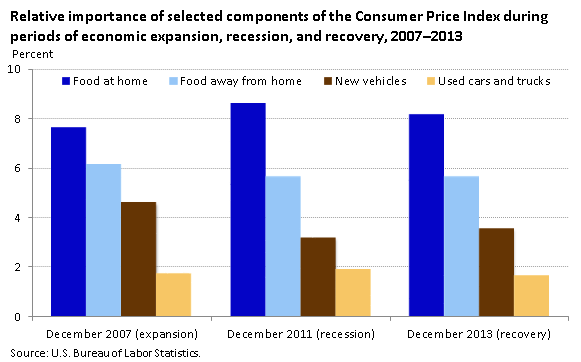An official website of the United States government
 United States Department of Labor
United States Department of Labor
Consumer spending behavior varies considerably depending on whether the economy is in an expansion, recession, or recovery period. Consumers may be more likely to purchase a new car during an economic expansion, for example, or less likely to go out to dinner during an economic downturn. The relative importance of the “food at home” component of the Consumer Price Index increased between December 2007, when the economy was expanding, and December 2011, when it was in recession. By December 2013, when the economy was slowly recovering, the relative importance of food at home declined slightly.

| CPI component | December 2007 (expansion) | December 2011 (recession) | December 2013 (recovery) |
|---|---|---|---|
Food at home | 7.66 | 8.64 | 8.19 |
Food away from home | 6.17 | 5.67 | 5.70 |
New vehicles | 4.63 | 3.20 | 3.56 |
Used cars and trucks | 1.77 | 1.91 | 1.67 |
Similarly, the relative importance of the “new vehicles” component of the CPI dropped substantially from December 2007 to December 2011, while the relative importance of used cars and trucks increased during that period. From December 2011 to December 2013, a period of modest recovery, the new vehicles component increased slightly while that for used cars and trucks declined (although neither returned to its prerecession level).
These data are from the Consumer Price Index program and the Consumer Expenditures survey. To learn more, see “How does consumer spending change during boom, recession, and recovery?” (HTML) (PDF), by Steve Reed and Malik Crawford, Beyond the Numbers, June 2014. The relative importances of items in the Consumer Price Index are based on surveys of consumers’ purchasing behavior and show how consumer purchases have changed over time.
Bureau of Labor Statistics, U.S. Department of Labor, The Economics Daily, Relative importance of selected CPI components during the business cycle at https://www.bls.gov/opub/ted/2014/ted_20140710.htm (visited January 01, 2026).

